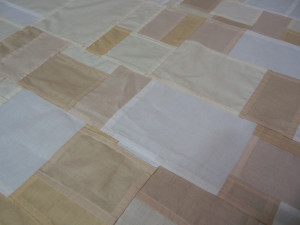Making a Pojagi
Have you ever heard of pojagi? It’s a Korean version of patchwork, designed to be hung from a window or a wall. A pojagi only has one layer and is somewhat sheer. Usually, the fabrics are very close in color. The seams are what we, in the U.S., call French seams. That is, the raw edges are enclosed, like they are in jeans.
You can see several modern pojagi here.
My son is obsessed by all things Korean and has asked me to make him a pojagi for Christmas. I’ve done so and the great unveiling will occur SOON.
Here’s an in-progress photo. Click on any image for a larger view

Perhaps you can make out the unusual French seam stitching technique. Seams are offset when stitching and a 5/8″ seam allowance is used. Then, the piece with the wider seam allowance is ironed over the skinnier side, enclosing all raw edges. Then both seam allowances are pressed to the side and top stitched. In the photo above, most seams are complete, but several have had their first stitching only.
It’s a little bit time consuming since each seam has to sewn twice and pressed twice. But the heavy seams will be the primary part of the design when the pojagi is hung in front of a window.
Here’s another in-progress photo, showing things as they moved along. The colors are very subtle. (But the colors in the top photo are more accurate.)
My son has given this piece a Korean name, which I’ll stitch into the corner. I’m looking forward to giving it to him! And I’ll show you the finished product, too.
Ellen Lindner
Update: My son informs me that pojagi were traditionally made from scraps and they were used to wrap around things. One application was wrapping a hot pot so it could be carried. Their use as art is relatively new. (He also tells me that pojagi can also be spelled bojagi. The proununciation is in between a p and a b.)

